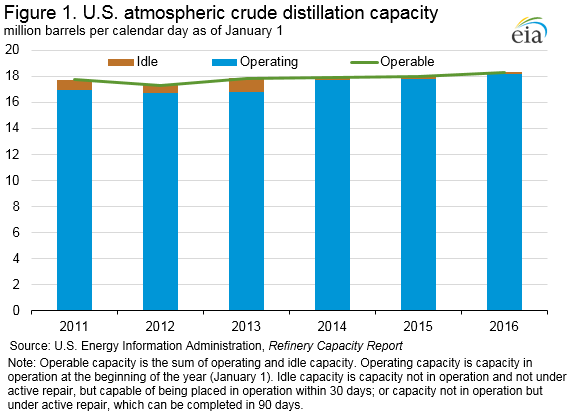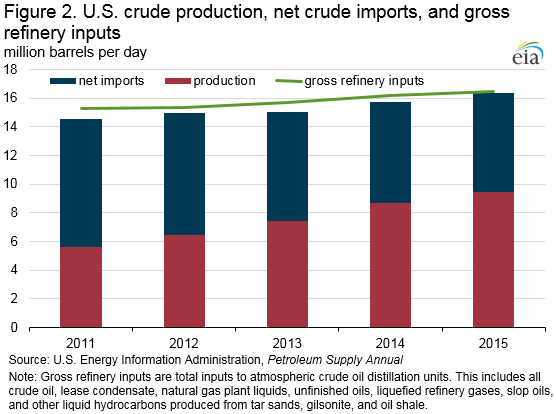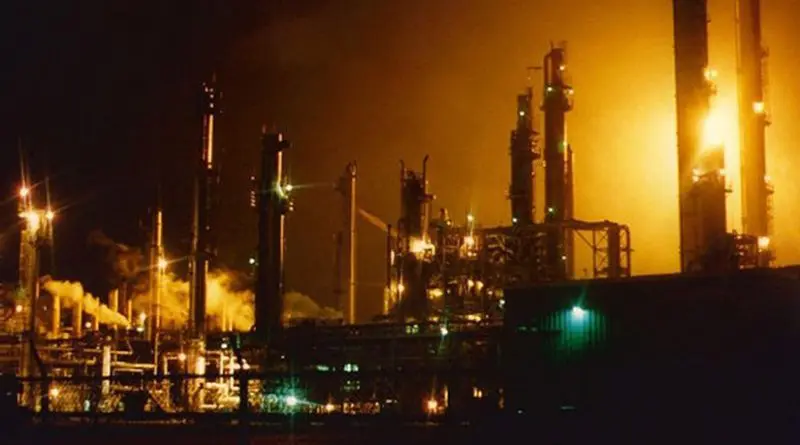US Refinery Capacity Rises 1.9% – Analysis
By EIA
US operable atmospheric crude distillation capacity as of January 1, 2016 was 1.9% higher than at the beginning of 2015, reaching 18.3 million barrels per calendar day (b/cd) according to EIA’s recently released annual Refinery Capacity Report (Figure 1).
This is the largest increase in operable capacity since the 2.9% increase as of January 1, 2013 over the start of 2012 that resulted from the restart of East Coast refineries that had closed in 2011. The capacities of secondary units that support heavy crude processing and production of ultra-low sulfur diesel and gasoline, including thermal cracking (coking), catalytic hydrocracking, and hydrotreating/desulfurization, also increased slightly.
EIA’s Refinery Capacity Report and this article measure refinery capacity in b/cd and barrels per stream day (b/sd). B/cd is a measure of the amount of input that a distillation unit can process in a 24-hour period under usual operating conditions. It takes into account both planned and unplanned maintenance. B/sd, another measure of refinery capacity, is the maximum number of barrels of input that a distillation facility can process within a 24-hour period when running at full capacity under optimal crude and product slate conditions with no allowance for downtime. Stream day capacity is typically 6% higher than calendar day capacity.
The refinery capacity reported for the start of 2016 includes two new refineries that began operating in 2015. Petromax Refining Company LLC started a 25,000 b/cd refinery in Houston, Texas, last summer and Buckeye Partners LP began operating a 46,250 b/cd condensate processing facility in Corpus Christi, Texas, in the fourth quarter of 2015.
Increased refinery runs—based on increases in both capacity and utilization—have continued to accommodate increases in U.S. crude oil production, which averaged 9.4 million b/d in 2015 (3.8 million b/d higher than in 2011). Gross inputs to refineries averaged a record 16.4 million b/d in 2015, compared with 15.3 million b/d in 2011. Operable refinery capacity increased 0.2 million b/cd and utilization increased 5 percentage points compared with 2011, resulting in the 1.1 million b/d increase in gross inputs. Over the same period, crude imports decreased by 1.6 million b/d and crude exports increased by 0.4 million b/d (Figure 2).
The Refinery Capacity Report also includes information on expansions planned for the balance of 2016. Capacity is expected to expand by an additional 160,000 b/sd later in 2016. Valero Energy plans to add an 87,000 b/sd condensate splitter at its Houston refinery and increase capacity by 23,000 b/sd at the McKee refinery in Sunray, Texas. Other projects to increase capacity by the end of 2016 include expansions at HollyFrontier Corporation’s Woods Cross refinery in Utah; CHS McPherson Refining in Kansas; Marathon’s Robinson, Illinois, refinery; and St. Paul Park Refining Company in Minnesota. Further investment in refinery expansion projects will depend on expectations about crude oil price spreads and the relative economic advantage of the U.S. refining fleet compared with refineries in the rest of the world.
U.S. average regular gasoline retail price declines, average diesel fuel price steady
The U.S. average regular gasoline retail price decreased two cents from the previous week to $2.33 per gallon on June 27, down 47 cents from the same time last year. The Midwest price dropped eight cents to $2.29 per gallon, followed by the East Coast price, down two cents to $2.26 per gallon, and the Rocky Mountain price, down one cent to $2.32 per gallon. The West Coast price rose four cents to $2.76 per gallon, while the Gulf Coast price was virtually unchanged at $2.10 per gallon.
The U.S. average diesel fuel price was unchanged from a week ago, remaining at $2.43 per gallon, down 42 cents from the same time last year. The Rocky Mountain price rose by two cents to $2.43 per gallon, the West Coast price increased by one cent to $2.71 per gallon, and the Midwest price rose modestly, remaining at $2.39 per gallon. The Gulf Coast price dropped by one cent to $2.29 per gallon, while the East Coast price dipped marginally, remaining at $2.44 per gallon.
Propane inventories gain
U.S. propane stocks increased by 2.5 million barrels last week to 82.1 million barrels as of June 24, 2016, 1.5 million barrels (1.8%) lower than a year ago. Midwest, Gulf Coast, East Coast, and Rocky Mountain/West Coast inventories increased by 1.7 million barrels, 0.5 million barrels, 0.2 million barrels, and 0.1 million barrels, respectively. Propylene non-fuel-use inventories represented 4.0% of total propane inventories.

